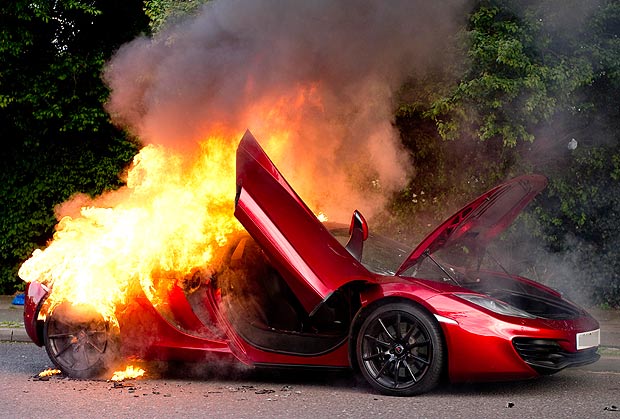
[Ed: And now for something not completely different. Going armed is fundamentally simply being prepared for dangerous emergencies; so is being equipped to fight fires. I’ve put out a couple of auto fires, and our author has stopped three or four. This is a more common hazard than most think, and deserves attention by all guardians and sheepdogs. Pictured is a McLaren — man, that hurts!]
Disclaimer: I am not an auto mechanic, but have read the daily newspaper for over a half a century, and believe I have useful insights into the causes of auto fires.
I fought my first auto fire in 1981 while living in Madison, Wisconsin. A battery in a woman’s car had exploded, and the entire ground under her car was burning, due to the battery acid. She had run to a nearby apartment complex to ask that the fire department be called (this was before we all had cell phones). At that time, the only equipment I was carrying was a 5-BC fire extinguisher. Nonetheless, with this and the help from two other motorists who also had small extinguishers, we were able to extinguish the fire before the fire truck arrived.
In my opinion, there are three causes of auto fires: 1) electrical problems, 2) crashes (the most common cause), and 3) debris on the road that punctures the gas tank. Recently, in the city where I live, a 2-year old was riding in her car seat of her grandparents’ car on an Interstate when debris punctured the gas tank and the car burst into frames. A motorcycle policeman amazingly smashed the side window with his elbow, and pulled the grandparents to safety. A female veterinarian driving by rescued the child, despite the smoke and flames, but sadly, the child died a few days later in a local hospital.
How common are car fires? Here are the facts from the National Fire Protection Association:
- U.S. fire departments responded to an estimated average of 152,300 automobile fires per year in 2006-2010. These fires caused an average of 209 civilian deaths, 764 civilian injuries, and $536 million in direct property damage.
- Automobile fires were involved in 10% of reported U.S. fires, 6% of U.S. fire deaths.
- On average, 17 automobile fires were reported per hour (my emphasis). These fires killed an average of four people every week.
- Mechanical or electrical failures or malfunctions were factors in roughly two-thirds of the automobile fires.
- Collisions and overturns were factors in only 4% of highway vehicle fires, but these incidents accounted for three of every five (60% of) automobile fire deaths.
- Only 2% of automobile fires began in fuel tanks or fuel lines, but these incidents caused 15% of the automobile fire deaths.
If you are serious about being a volunteer first responder to car fires, I recommend being equipped as follows:
- A pocket knife with a serrated blade, of the maximum length allowable by law – in my state this is 3 3/4”. You will need this to cut seat belts that can become jammed after wrecks.
- A NOMEX™ face hood that covers your entire face/neck except for the eyes.
- Heat-resistant goggles.
- Fireplace gloves: These are made of heavy leather and cover your hands and forearms.
- Some device to break out the side windows, e.g., a collapsible baton (I like the ASP™, a Life Hammer™, or a tire iron). I recommend the first two as these can be stored next to you so as to be quickly accessible.
- A minimum of a 2-A 10-BC dry chemical fire extinguisher (5 lbs), with a metal head and flexible rubber hose nozzle. This is also what I have in my home. Mine is 15” long and 4” wide. They can be mounted in your vehicle’s trunk.
A quick review: What do “A, B, C” ratings mean? Here are the “official” definitions:
- A-rated extinguishers will put out trash-wood-paper-plastics. A 2-A extinguisher will put out a 10×10’ wood panel that is on fire.
- B-rated extinguishers will put out liquids, like gasoline. A 10-BC extinguisher will put out 31 gallons of Heptane. According to Wikipedia, “n-Heptane is defined as the zero point of the octane rating scale. It is undesirable in gasoline, because it burns explosively”.
- C-rated means that the extinguisher is safe to use on electrical equipment.
Practical advice:
- Except for the fire extinguisher, knife, and breaker device, put your other items in an empty tool box, label it “FIRE EQUIPMENT”, and keep the box in your trunk.
- Park your car far away from the burning vehicle, perhaps 100 feet.
- Before you engage the fire, call 911 on your cell phone and report the situation and location.
- You will probably not be fighting a vehicle fire alone. It is my understanding that all DOT-regulated vehicles are required to carry fire extinguishers, e.g., trucks of all types, school buses, etc. Ditto for ambulances and police cars. And many motorists carry extinguishers. There are many good Samaritans, as reported daily in the news media.
- Be very wary of fighting fires involving tanker trucks! The average over-the-road 18-wheeler carries 240 gallons of diesel fuel. Secondly, you don’t know what they are carrying in the tanker: Is it milk, gasoline, or some corrosive chemical that gives off deadly vapors if burning? Best to leave these to the professionals.

— Warren Lind is a retired licensed clinical social worker and a full-time security officer who writes extensively about crime, survival, and self-defense. He a long-time CCW holder and is a member of too many pro-2A organizations to list.
